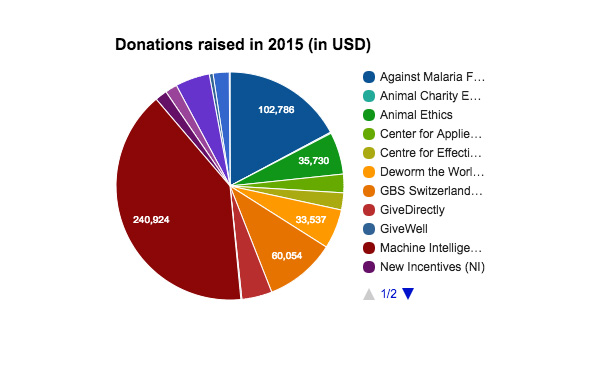Raising for Effective Giving release their 2015 Annual Report showing that poker players donated over half a million dollars to effective charities and over $1.5m since the foundation’s birth in 2014.
A child dies every 30-seconds due to Malaria.
 Someone, somewhere, likely sub-Saharan Africa, has just passed away in the time it took me to write my opening statement.
Someone, somewhere, likely sub-Saharan Africa, has just passed away in the time it took me to write my opening statement.
Some experts believe 2.7 million people die each year, and 70% of those deaths happen to children under five years of age. To put a visual on that consider that the mortality rate is the equivalent of seven jumbo jets full of children vanishing daily.
I have a child due in September.
At the other end of the spectrum, I have just finished walking around my rich neighbourhood in Los Angeles, listening to the Malcolm Gladwell Podcast Revisionist History on my rather expensive iPhone.
During the episode titled My Little One Hundred Million I learned that at the end of 2013 the market value of the endowment funds of the colleges and universities of the United States topped $467 billion.
In 2015, despite Harvard University having $32.6 billion in the bank, John A. Paulson, an American Hedge Fund Manager, gave them an additional $400m. Earlier this year, Philip H. Knight, the co-founder of Nike, gave $400m to Stanford University. They have $18.6 billion in the bank.
And a few more children have just passed away.
If billionaires don’t step up, Harvard will soon be down to its last $30 billion.
— Malcolm Gladwell (@Gladwell) June 3, 2015
When it comes to making a difference in the world, I can’t think of a more fucked up place to dig starting blocks into the ground that the poker industry.
At the heart of the game you have two competitors with the sole focus of bankrupting each other. To be successful in poker, you need to seek out players who are weaker than you and win as much money from them as you can.
And what do we then do with that money?
Buy a new pair of Nike shoes from Philip H. Knight so he can plough your money into Stanford?
Buy an expensive sports car so you can look cool?
Buy a $300 pot of caviar because you can?
The great thing about life is it never stays still. The face we wear today will change tomorrow.
Sometime in the 1990s when I was getting my rocks off to Primal Scream, the industrialist Hank Rowan gave $100m to a bankrupt little university in New Jersey called Glassboro State. His generous donation was a one of a kind. Then it wasn’t. It kick started something. Philanthropists followed suit and a few decades later we arrive at that $467 billion figure.
People like a trend.
Being a philanthropist is cool.
Poker caught on.
The World Poker Tour (WPT) Foundation, The CalvinAyre Foundation, PokerStars partnered with Right to Play, and the World Series of Poker (WSOP) partnered with the ONE DROP Foundation.
At the macro level, the poker industry started raising millions of dollars for various causes around the world.
But there was also something happening at the micro level.
Philipp Gruissem has earned over $10m playing live poker tournaments and $3m playing online.
Sometime in late 2013, a young Gruissem was a little bit lost. Poker had become unsterilised. He had reached the ceiling of happiness that money can buy. And he was about to walk out on the industry and run away to join a convent somewhere in a part of the world where kids are carted onto jumbo jets and forgotten about.
What a travesty that would have been.
Fortunately, Gruissem found effective altruism and created Raising for Effective Giving (REG). We now had an initiative at the micro level. Gruissem and his team urged poker players to donate a percentage of their gross winnings to charities that focused on doing the best they could do through a rational thinking process inspired by a young man called William MacAskill, the author of Doing Good Better and the founder of 80,000 Hours.
REG formed in 2014 during the WSOP. It has since created over $1.5m in donations. While it has branched out into other areas, poker remains its core focus.
The effective altruist movement has recently released their 2015 report. There are now 260 REG members, and in 2015 they helped donate $597,820, and when you deduct REG expenses, you are left with an unbelievable fund ratio of 1:8 (at the time of writing that figure is 1:10).
The Against Malaria Foundation (AMF) received $102,786 good enough to buy 45,000 anti-malaria bed nets protecting 69,000 people for up to four years from this fatal disease.
This pie chart shows you where the rest of the money went.

Regarding respective cause areas, $176,296 (29.5% of donations) was given to charities supporting poverty alleviation such as AMF, Deworm the World Initiative (DtWI), and GiveDirectly.
$61,166 (10.2% of donations) passed to animal charities such as Animal Charity Evaluators (ACE), Animal Ethics (AE), and the Great Ape Project (GAP).
$240,924 (40.3% of donations) went to charities looking into risks that could present themselves through emerging technologies with the money going towards the Machine Intelligence Research Institute (MIRI) looking amongst other things, the advancement of Artificial Intelligence (AI).
$119,434 (20% of donations) went to cause-neutral meta-charities that don’t focus on any one particular charity but does work similar to REG such as the Effective Altruism Foundation, Center for Applied Rationality (CFAR), and Centre for Effective Altruism (CEA).
Here is the full report.
Moving forward, REG plan to partner with All In For Africa (AIFA) to host a special AIFA tournament at the Running Aces Casino in Columbus, MN, on Sep 24. A similar event in April, raised $14,000 for the AMF, providing 6,000 anti-malaria bed nets, positively affecting 9,000 people’s lives.
All in all, poker is one of the most charitable sports in the world, proving that humanity can find salvation and service in the most unlikeliest of places.
